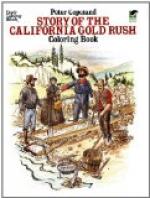Many of the old Spanish settlers and explorers have left us their names, though they are themselves forgotten, as Martinez, Amador, Castro, Bodega, and countless others plainly show. The Englishmen Livermore, Gilroy and Mark West, those early settlers, Temple and Rice at Los Angeles, Yount and Pope of Napa Valley, Don Timoteo Murphy of San Rafael, and Lassen the Dane, for whom Lassen’s Peak was named, were among those who came here before 1830.
Governor Figueroa, called the “benefactor of Alta California” ordered the Missions to be given up to the Indians. By directing that the town of Yerba Buena should be laid out, he also is remembered as the founder of San Francisco. Richardson, who carried out the governor’s orders, was the first settler and Leese built the first frame-house of San Francisco.
In Governor Alvarado’s time many Americans came to the new country, although Alvarado and General Vallejo tried hard to keep them out. Vallejo was then the military commander, and had headquarters at Sonoma, where he had an adobe fort and a few soldiers to protect the Mission of Solano. Here General Vallejo was living with his Indian and Californian settlers when the place was taken by Ide, the leader of the “bear-flag party.” Vallejo, set free when the short-lived “bear-flag republic” went to pieces, lived many years at Sonoma. He was afterwards a member of the first legislature. He tried hard in 1851 to have the state capital at Vallejo; but he failed, for he did not keep his agreement to put up buildings for government use.
A man well known in the early days was John Sutter, a Swiss, who built a fort and settled where Sacramento now stands. He called his colony New Helvetia, and soon had about three hundred Indians at work for him. Some of the men were carpenters, blacksmiths, and farmers, while the women wove blankets or a coarse cloth. His fort enclosed about an acre of ground, with an adobe wall twenty feet high. A large gate was shut every night to keep safe those inside this walled fort. You have read that Marshall, who found gold, was building a sawmill for Sutter when he picked up the precious yellow nuggets. Sutter and Marshall quarrelled at last about the ownership of the mill at Coloma, where the pieces of gold were picked up. Marshall died a poor man, unhappy and neglected by the state, which has since put a costly bronze statue over his grave.
Sutter was very active in the Micheltorena war, when Governor Micheltorena was defeated and put out of office by Alvarado and Castro.
The last of the Mexican governors, Pio Pico, tried his best to prevent the rush of Americans into his country, but though Castro, the military commander, helped him, the Americans came and stayed. And both Pico and Castro with their soldiers were driven out of California at last by Fremont and Stockton.




